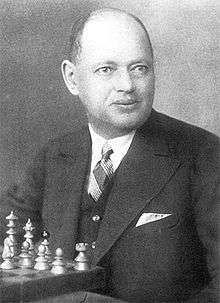Rudolf Spielmann
| Rudolf Spielmann | |
|---|---|
 | |
| Full name | Rudolf Spielmann |
| Country | Austria |
| Born |
5 May 1883 Vienna, Austria-Hungary |
| Died |
20 August 1942 (aged 59) Stockholm, Sweden |
Rudolf Spielmann (5 May 1883 – 20 August 1942) was an Austrian-Jewish[1] chess player of the romantic school, and chess writer.
Career
Spielmann was a lawyer but never worked as one.
He was known as "The Master of Attack" and "The Last Knight of the King's Gambit". His daredevil play was full of sacrifices, brilliancies, and beautiful ideas. This was exemplified, for example, in the 1923 Carlsbad tournament, where he did not have a single draw (with five wins and twelve losses).
Despite a strong opposition at that time with players like Alexander Alekhine, José Raúl Capablanca, Emanuel Lasker, Siegbert Tarrasch, Akiba Rubinstein, Aron Nimzowitsch, and Savielly Tartakower, Spielmann managed to score well in numerous tournaments. He won 33 of the roughly 120 in which he played, including Stockholm 1919; Bad Pistyan 1922; and Semmering 1926. He is also remembered as the author of the classic book The Art of Sacrifice in Chess .
As a Jew, Spielmann had to flee from the Nazis, escaping to Sweden. He died in Stockholm in great poverty.
Results versus Capablanca
Spielmann was one of few players to have an even score (+2 −2 =8) against Capablanca, one of an even fewer number to win more than one game against him, and the only player to fulfill both of those. Both of Spielmann's wins came shortly after Alekhine dethroned Capablanca as World Champion in 1927: at Bad Kissingen 1928 and Karlsbad 1929. The latter tournament is generally regarded as his best tournament result, as he scored 14½ out of 21, tied for second with Capablanca, a half point behind Aron Nimzowitsch. Here is one of Spielmann's wins:
| a | b | c | d | e | f | g | h | ||
| 8 |  | 8 | |||||||
| 7 | 7 | ||||||||
| 6 | 6 | ||||||||
| 5 | 5 | ||||||||
| 4 | 4 | ||||||||
| 3 | 3 | ||||||||
| 2 | 2 | ||||||||
| 1 | 1 | ||||||||
| a | b | c | d | e | f | g | h | ||
Capablanca–Spielmann, Bad Kissingen 1928
1.d4 d5 2.c4 c6 3.Nc3 Nf6 4.Nf3 dxc4 5.e3 b5 6.a4 b4 7.Na2 e6 8.Bxc4 Be7 9.0-0 0-0 10.b3 c5 11.Bb2 Bb7 12.Nc1 Nc6 13.dxc5 Na5 14.Ne5 Nxc4 15.Nxc4 Bxc5 16.Nd3 Qd5 17.Nf4 Qg5 18.Bxf6 Qxf6 19.Rc1 Rfd8 20.Qh5 Rac8 21.Rfd1 g6 22.Rxd8+ Qxd8 23.Qe5 Be7 24.h3 Rc5 25.Qa1 Bf6 26.Rd1 Rd5 27.Rxd5 exd5 28.Ne5 Qd6 29.Nfd3 Ba6 (diagram) 30.Qe1 Bxe5 31.Nxe5 Qxe5 32.Qxb4 Bd3 33.Qc5 Qb8 34.b4 Qb7 35.b5 h5 36.Qc3 Bc4 37.e4 Qe7 38.exd5 Bxd5 39.a5 Qe4 0–1
Quotes
- According to Richard Réti, Spielmann demonstrated "unusual resourcefulness in complicated situations, in which he felt perfectly at home."
- Spielmann himself believed "A good sacrifice is one that is not necessarily sound but leaves your opponent dazed and confused."
- "Play the opening like a book, the middle game like a magician, and the endgame like a machine." – Spielmann
References
- ↑ Chess and Jews by Edward Winter at www.chesshistory.com
Further reading
- The Art of Sacrifice in Chess by Rudolf Spielmann, Dover, ISBN 0-486-28449-2.
- The Masters: Rudolf Spielmann Master of Invention, Neil McDonald, Everyman Chess, ISBN 1-85744-406-X.
External links
- Rudolf Spielmann player profile and games at Chessgames.com
- Chessville book review